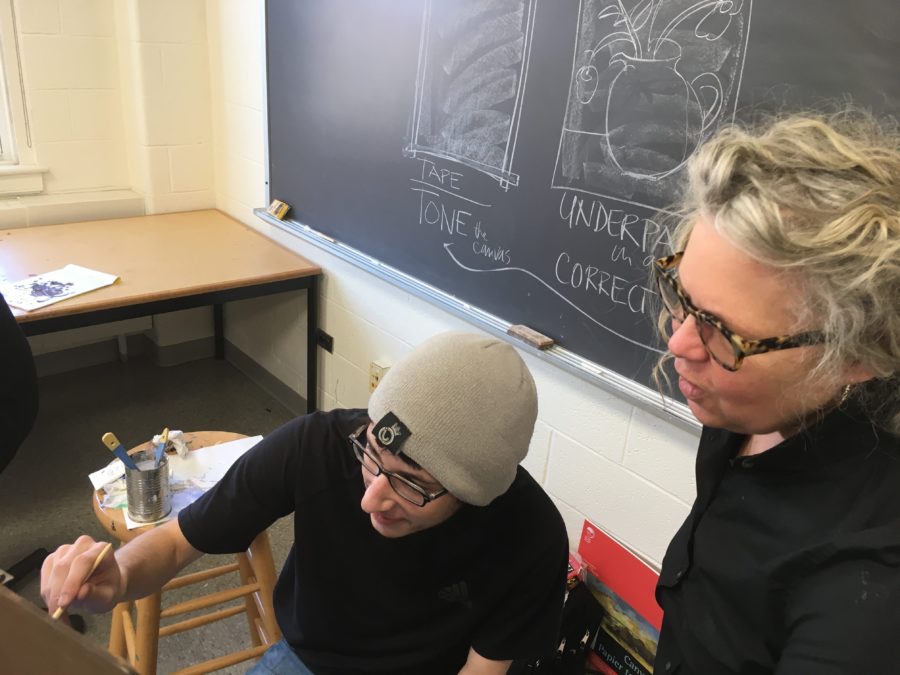Duston Spear’s Sentence: Art in Prison
Duston Spear came to work one day during the fall 2016 semester and her director told her she couldn’t bring the color blue to her art class anymore.
“I’m thinking [to myself], ‘How am I going to teach the Impressionists if I can’t have [students] paint with the color blue?’” Spear said. “The fear was that the women would paint their state green clothes blue and pass as a corrections officer.”
The ludicrous rule wasn’t intended for her Pace art class, however; it was aimed towards her class of inmates at the Bedford Hills Correctional Facility for Women—the only all women’s maximum security prison in New York state—where she has taught for the past 15 years.
The Virginia native first discovered the prison in 2001 when she moved to Westchester from SoHo and while driving around with her daughter, Emma, she stumbled upon the prison.
“We were kind of lost, so used to New York [City], and not having a car and so we would drive around,” said Spear, a mother of two daughters. “I drove around and I went, ‘what is this?’ It’s this huge complex with Bedford Hills on one side and the Taconic on the other.
“I asked people about it, but the locals weren’t very involved with it. It’s really bizarre the way it’s right there, but a lot of people just choose to not see it.”
Spear chose to see it and see what it had to offer. Emma, however, had osteosarcoma—a common type of cancer that developed in her femur—at the time, underwent surgery, and needed chemotherapy.
The two “lived” at Mt. Sinai Hospital’s pediatrics floor in Manhattan for a couple of years for the chemo treatment when Spear related the feeling of being trapped within the hospital for something to how the prisoners in Bedford Hills might feel.
“The prison seemed very much like that thing where you don’t want to live in a children’s cancer ward; you don’t want to be in prison,” said Spear, who also taught at Sing Sing Prison for two years. “I thought there are probably people stuck in there that have a similar feeling like, ‘I’m here; I can’t get out of it.’ So, I looked into teaching there.”
She started teaching art at Pace because it was one of six schools that had a program that offered college courses to inmates. Spear initially did it through Pace, but they discontinued it. So, she went through Marymount Manhattan College instead.
Teaching in a prison came with difficulties, however, because of New York State Department of Corrections’ intricate rules such as no fruit because inmates can make alcohol out of it or no notebooks with metal rings or plastic because it can be used as a weapon.
She had to improvise in order to teach.
“It’s very challenging to teach [in prison],” said Spear, who never asks what prisoners are in for because it can be difficult to separate them from their crime. “I thought, well we can have models, clothed models, but inmates that are not assigned to the college program can’t be in that room. You learn all these incredibly creative ways to teach a class.”
Spear’s choice to work at a prison wasn’t for volunteer/community service or to make herself feel good. The art professor genuinely wanted to help people who are trapped, per se, succeed in and out of prison.
And her students shared the same view and see the courses as an avenue to change and reintegrate themselves back into society after their sentence.
Spear is a firm believer in the rehabilitation of inmates through education and the arts. In fact, one of her teaching assistants at Bedford Hills was Judith Clark, who was sentenced 75 years in jail for her involvement in an infamous 1981 Rockland armored-car robbery where three people were slain but has undergone a transformation of sorts through poetry.
Clark’s sentence was commuted—a form of clemency that reduces the punishment for a crime—by Governor Andrew Cuomo in December 2016 because of her “exceptional strides in self-development.”
“I guess if you were to define types in prison, you’d have the ‘thugs’ in the yard, which could refer to a male or a female, and then you have those people who have chosen to change,” said Katherine Vockins, the founder of the Rehabilitation Through the Arts organization, which operates in five maximum security prisons. “They’ve said to themselves, ‘enough of [this], I am going to choose to change, and I am going to look for positive programming.”
As out of the ordinary as teaching at a prison may be, it’s commonplace for Spear. But she just waits every year to see what odd rule is enforced next.
Your donation supports independent, student-run journalism at Pace University. Support the Pace Chronicle to help cover publishing costs.


